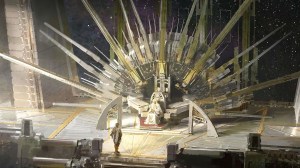2020 has been one wild ride and with just over a month left in this insane year that has seen not only a global pandemic but such hits as murder hornets, zombie minks, near miss asteroids and a whole host of other semi-horrifying items that have become weirdly normal, there’s yet another terrifying thing we can add to the list. It turns out that planet Earth is 2000 light-years closer to the supermassive black hole at the center of our galaxy than we realized.
Videos by ComicBook.com
According to CNET, scientists have discovered that we’re closer to Sagittarius A, the supermassive black hole at the heart of the Milky Way, than previously believed. Per the report, this information doesn’t represent a threat or that something has changed in terms of our position as relative to that black hole, just that we now have a more accurate model of the galaxy thanks to new data, hence the update.
The update comes from VERA, a Japanese radio astronomy project that has been gathering data using a technique called interferometry for the last 15 years. VERA gathered data from various telescopes across Japan and then used that data along with other projects to create what is currently the most accurate map of the galaxy. That new accurate map includes pinpointing the location of Sagittarius A which turns out is 25,800 light-years away, a distance that is 2000 light-years closer than previously estimated. On top of that, it turns out that Earth is also moving faster than we thought previously. The new model from VERA has Earth orbiting the galaxy’s center at 227 kilometers (that’s 141 miles) per second — previous models had the speed clocked at 220 kilometers (136 miles) per second.
This also isn’t likely to be the last update we get on the Earth’s position relative to that supermassive black hole, either. Scientists behind VERA are looking to continue increasing their model’s accuracy, this time by increasing the number of data points by expanding into the East Asian CLBI Network (EAVN) and, thus, getting data from even more radio telescopes located through Japan, Korea, and China.
While this update isn’t a “big deal” in the sense that it puts us on a collision course to impending doom — 2000 light-years is a very long distance, after all — black holes are no joke. Earlier this month, astrophysicist Janna Levin released her latest book Black Hole Survival Guide, detailing what could happen to the human body should we ever get close enough to a black hole that it would be an issue and, well, it’s pretty horrifying.
“As you fall toward the singularity, you are badly broken. The part of your body closest to the singularity is accelerated drastically faster than the part of your body farthest from the singularity, stretching you miserably,” the cosmologist writes in the book’s excerpt, first published by the BBC’s Science Focus magazine. “Simultaneously, your overall anatomy is forced to converge toward that point, crushing you. In a microsecond, less time than it would take to blink your eye, you are simultaneously flayed, shredded, and pulverised to death.”
We’ll take our chances with the murder hornets, thanks.
What do you think about this update on our planet’s proximity to the supermassive black hole Sagittarius A? Let us know in the comments.
Photo: AHMAD GHARABLI/AFP via Getty Images








